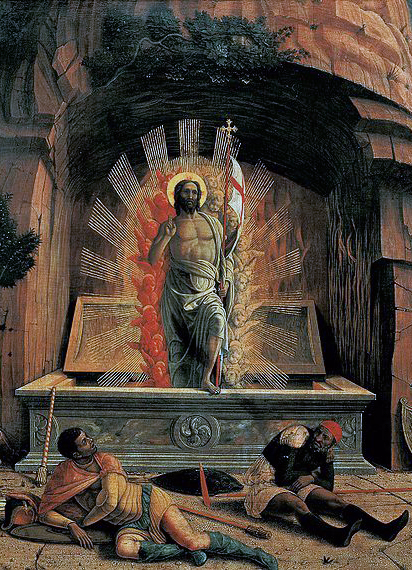With the characteristic symmetry of the Renaissance, Mantegna composed this Resurrection in which the resurrected Jew is the luminous axis of the scene (see the complete painting: here), surrounded by the heads of red angels on his right and white angels on his left.
Always keep in mind that the doctrine of the Resurrection was plagiarised by the Jews who originated the Christian sect. They simply used the story of the founding hero-God of the Romans: Romulus. The idea of those who wrote the New Testament was simply to use the mythological biography of the white God to convince the Romans to better worship the god of the Jews.
The parallels between the old Romulus and the new Jesus invented by the rabbis are so obvious that a few are worth mentioning: Both are sons of God; their deaths are accompanied by prodigies and the land is covered in darkness; both corpses go missing; both receive a new immortal body superior to the one they had; their resurrected bodies had on occasion a bright and shining appearance; after their resurrection they meet with a follower on a road from the city; a speech is given from a high place prior to the ‘translation to heaven’; there is a ‘great commission’ or instruction to future followers; they physically ascend to heaven and, finally, they are taken up into a cloud.
Every single Westerner has heard the story that these rabbis concocted about Jesus. But who knows the original legend, that of the Aryan hero-God Romulus?
Judea’s victory over Rome is complete even among those racially conscious Christians who mistakenly fancy themselves as anti-Semites.

4 replies on “The resurrected Jew”
Jesus was the first magic negro.
He didn’t even exist.
It’s not just the Romulus myth. The Golden Bough goes into this in exhaustive detail: there are a multitude of death-and-resurrection stories of gods, most of which echo each other beat for beat, arising in cultures that could not possibly have had any contact. You find similar elements in Mesoamerican myths, stories from African tribal villagers, Southeast Asia, and Phrygian and Mesopotamian religions. The Jesus story echoes all of these.
CS Lewis’s argument to Tolkien (which reportedly Tolkien found convincing) was that these similarities could not exist if there wasn’t some common element of truth in them. He neglected to address the fact that the one case he declares as being the origin and cause of all the others came chronologically last.
The Golden Bough touches on this too – that the extent to which Christianity was borrowing concepts were remarked upon when paganism was still common – and notes that the early Christians came up with a very obvious and logical explanation for it; that the Devil had surpassed himself in evil by somehow inverting the usual order of cause and effect.
Yes. Carrier mentions all the other gods: the biggest flaw in fundamentalist theological circles, as they ignore the surrounding religions and mystery cults of the 1st century.